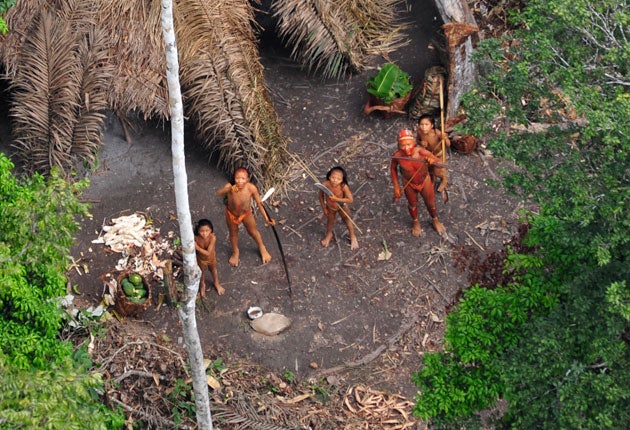They are some of the most isolated people on earth, a small civilisation which has spent its entire history cut off from the rest of the world by thousands of miles of wilderness, learning to eke an existence from the plants and creatures of the Amazon rainforest.
Now they face a grave threat. Fears are growing about the future of one of the world's last un-contacted tribes, amid claims by a British human rights organisation that the government of Peru is planning to re-write strict laws supposed to protect their remote jungle territory.
The community was discovered in 2008, when it was spotted by a conservationist flying over rainforest near the country's north-eastern border with Brazil. Footage showed them brandishing weapons and staring at the unfamiliar machine in the sky.
Three years later, the still-unnamed community is the subject of a diplomatic row amid allegations officials plan to quietly abolish the Murunahua Reserve, which was set up to prevent indigenous groups from coming into contact with outsiders.
Survival International says Peru's government plans to allow loggers to begin exploiting valuable mahogany and oil resources within the 1.2 million-acre reserve, hundreds of miles from the nearest towns and cities.
That would spell disaster for the tribe, since "first contact" usually results in the death of between 50 and 80 per cent of a population – because they have no immunity to diseases which are relatively common elsewhere. When illegal loggers and ranchers discover tribes on land they intend to exploit, they often seek to drive them away by any means.
Within a few years of oil prospectors making contact with the Nahua tribe in south-east Peru the early 1980s, more than half of the tribe's people had died from diseases brought in by the prospectors. A different but no less tragic fate befell the Akuntsu tribe in Brazil. When the government made contact in 1995, they discovered that cattle ranchers had massacred almost the entire tribe. Only five Akuntsu people now remain.
Survival International, which campaigns on behalf of indigenous peoples across the world, says that Peru's indigenous affairs department, INDEPA, is planning to abolish the Murunahua Reserve "because it does not believe there are uncontacted tribes living there". The department believes they are on the Brazilian side of the border, claims Survival.
Viewers of the BBC's Human Planet programme may beg to differ. In February, they saw long-lens footage shot from another aircraft. On the show, Sir David Attenborough explained that it showed some of the first-ever footage of a small community, apparently wearing orange body paint. As the plane flew over treetops a kilometre away from their settlement, and very much inside Peru, viewers were told that the indigenous people "remind us it's possible to live in a different way ... they're the last free people on the planet".
In a statement accusing the Peruvian authorities of reneging on previous commitments to protect the now high-profile tribe, Survival's director, Stephen Corry, said they had "cynically" paved the way for the reserve to be abolished, by turning a blind eye to recent illegal intrusions.
A recent investigation by the US- based Upper Amazon Conservancy found five illegal logging camps inside the Murunahua. "Since the government has done nothing to stop the influx of loggers, the Indians seem to have fled into the Brazilian portion of the wilderness," he said. "So now the government intends to abolish the reserve because it says the Indians are no longer living there."
Survival says it heard of the threat to the tribe's reserve from partner organisations in north-eastern Peru. Its claims have, however, been vigorously denied by the country's government, which issued a statement saying "we have in no way even considered" abolishing laws protecting the area.
Peru's government is locked in a long-running battle with indigenous rights groups. In 2009, several tribes began blockading roads and holding public protests against plans to open up their homelands to oil and gas exploration. The row burst on to the international scene in June 2009, with a massacre which became known as "The Amazon's Tiananmen".
Dozens were killed and hundreds wounded when armed police opened fire on tribespeople demonstrating near the town of Bagua Grande. In March, Survival highlighted a US government cable, which had been distributed by Wikileaks. It said that between 70 and 90 per cent of Peru's mahogany exports were illegal, and suggested Lima was doing little to enforce the rules governing logging.
Given that Peru is in a state of political upheaval, many believe any guarantees should be taken with a pinch of salt. José Meirelles, the man who discovered the tribe in 2008, believes it would be "completely absurd" to abolish the reserve. "I would bet all my money that this is down to the interests of illegal logging and oil," he said.

Join our commenting forum
Join thought-provoking conversations, follow other Independent readers and see their replies
Comments